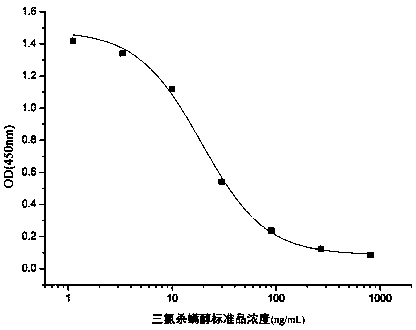Hybridoma cell strain CBC secreting monoclonal antibody of dicofol and application of hybridoma cell strain CBC
A hybridoma cell line, dicofol technology, applied in analytical materials, biochemical equipment and methods, instruments and other directions, can solve problems such as excessive residues, high solvent consumption, aquatic toxicity, etc., and achieve the effect of good detection sensitivity
- Summary
- Abstract
- Description
- Claims
- Application Information
AI Technical Summary
Problems solved by technology
Method used
Image
Examples
Embodiment 1
[0045] Example 1: Synthesis of dicofol hapten
[0046] Since small molecules of dicofol are not immunogenic and cannot stimulate mice to generate immune responses and then produce antibodies, it is necessary to couple dicofol to proteins through protein linkage technology to obtain immunogenicity; commonly used in protein coupling techniques Active groups include amino, carboxyl, hydroxyl, mercapto, etc. Since the molecular structure of dicofol does not contain these active groups, derivation is required.
[0047] Put dicofol (250 mg, 0.67 mmol), ethyl cyanoacetate (1 mL), and acetic acid (1 mL) together in a round bottom flask, and slowly add 96% sulfuric acid (4 mL). After the addition was complete, the mixture was heated in a 50 °C water bath for 15 min. The mixture turned dark red, and the reaction was stirred at room temperature for 20 h. The mixture was extracted with ether. The ether phase was washed with water and sodium bicarbonate solution, dried and concentrated....
Embodiment 2
[0049] Example 2: Synthesis of dicofol complete antigen
[0050] Weigh 5.5mg dicofol hapten (DCF-COOH), 4.2mg N-hydroxysuccinimide (NHS), dissolve in 300μL N,N-dimethylformamide (DMF), stir at room temperature for 10min; weigh again Take 6.9 mg of 1-(3-dimethylaminopropyl)-3-ethylcarbodiimide hydrochloride (EDC), fully dissolve it in 100 μL DMF, add it to the DCF-COOH solution, and stir at room temperature to react 6- 8 h (referred to as liquid A). Take 8mg KLH, dilute it to 4mg / mL with 0.01M carbonate buffer solution (CBS) (called solution B), then slowly add solution A to solution B drop by drop, react at room temperature overnight; then use 0.01M PBS solution Dialyze to remove the unreacted small molecule hapten to obtain the complete antigen DCF-COOH-KLH, which is identified by the ultraviolet absorption scanning method.
Embodiment 3
[0051] Embodiment 3: the synthesis of dicofol coating original
[0052] Dissolve 3.0 mg of dicofol hapten (DCF-COOH) and 2.3 mg of N-hydroxysuccinimide (NHS) in 300 μL of anhydrous N,N-dimethylformamide (DMF), and stir at room temperature for 10 min to obtain dicofol semi- Antigen (DCF-COOH) solution; 3.8 mg of 1-(3-dimethylaminopropyl)-3-ethylcarbodiimide hydrochloride (EDC) was dissolved in 100 μL of anhydrous DMF and added to DCF-COOH solution, stirred at room temperature for 6-8 hours to obtain liquid A; dilute 10 mg of chicken ovalbumin (OVA) with 1 mL of carbonate buffer solution (CBS) with a concentration of 0.01 mmol / L to obtain liquid B; Solution A was slowly added to solution B for reaction to obtain a reaction solution; the reaction solution was dialyzed with PBS solution to remove unreacted small molecule haptens to obtain the coating original (DCF-COOH-OVA).
PUM
 Login to View More
Login to View More Abstract
Description
Claims
Application Information
 Login to View More
Login to View More - R&D
- Intellectual Property
- Life Sciences
- Materials
- Tech Scout
- Unparalleled Data Quality
- Higher Quality Content
- 60% Fewer Hallucinations
Browse by: Latest US Patents, China's latest patents, Technical Efficacy Thesaurus, Application Domain, Technology Topic, Popular Technical Reports.
© 2025 PatSnap. All rights reserved.Legal|Privacy policy|Modern Slavery Act Transparency Statement|Sitemap|About US| Contact US: help@patsnap.com

